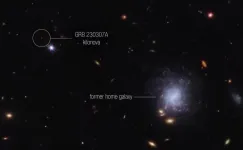(Press-News.org) For four years, NASA’s InSight lander recorded tremors on Mars with its seismometer. Researchers at ETH Zurich collected and analysed the data transmitted to Earth to determine the planet’s internal structure. “Although the mission ended in December 2022, we’ve now discovered something very interesting,” says Amir Khan, a Senior Scientist in the Department of Earth Sciences at ETH Zurich.
An analysis of recorded marsquakes, combined with computer simulations, paint a new picture of the planet’s interior. Sandwiched between Mars’s liquid iron alloy core and its solid silicate mantle lies a layer of liquid silicate (magma) about 150 kilometres thick. “Earth doesn’t have a completely molten silicate layer like that,” Khan says.
This finding, now published in the scientific journal Nature alongside a study led by Henri Samuel, Institut de Physique de Globe de Paris, that reaches a similar conclusion using complimentary methods, also provides new information on the size and composition of Mars’ core, resolving a mystery that researchers have until now been unable to explain.
An analysis of the initially observed marsquakes had shown that the average density of the Martian core had to be significantly lower than that of pure liquid iron. The Earth’s core, for example, consists of about 90 percent iron by weight. Light elements such as sulphur, carbon, oxygen, and hydrogen make up a combined total of around 10 percent by weight. Initial estimates of the density of the Martian core showed that it is comprised of a much larger share of light elements – around 20 percent by weight. “This represents a very large complement of light elements, bordering on the impossible. We have been wondering about this result ever since,” says Dongyang Huang, a postdoctoral researcher in the Department of Earth Sciences at ETH Zurich.
Fewer light elements
The new observations show that the radius of the Martian core has decreased from the initially determined range of 1,800–1,850 kilometres to somewhere in the range of 1,650– 1,700 kilometres, which is about 50 percent of the radius of Mars. If the Martian core is smaller than previously thought but has the same mass, it follows that its density is greater and that it, therefore, contains fewer light elements. According to the new calculations, the proportion of light elements dropped to between 9 and 14 percent by weight. “This means that the average density of the Martian core is still somewhat low, but no longer inexplicable in the context of typical planet formation scenarios,” says Paolo Sossi, Assistant Professor in the Department of Earth Sciences at ETH Zurich and member of the National Centres of Competence in Research (NCCRs) PlanetS. The fact that the Martian core contains a significant amount of light elements indicates that it must have formed very early, possibly when the Sun was still surrounded by the nebula gas from which light elements could have accumulated in the Martian core.
The initial calculations were based on tremors that had occurred in close proximity to the InSight lander. However, in August and September 2021, the seismometer registered two quakes on the opposite side of Mars. One of them was caused by a meteorite impact. “These quakes produced seismic waves that traversed the core,” explains Cecilia Duran, a doctoral student in the Department of Earth Sciences at ETH Zurich. “This allowed us to illuminate the core.” In the case of the earlier marsquakes, by contrast, the waves were reflected at the core-mantle boundary, providing no information about the deepest interior of the Red Planet. As a result of these new observations, the researchers have now been able to determine the density and seismic wave speed of the fluid core up to a depth of about 1,000 kilometres.
Supercomputer simulations
To infer the composition of the material from such profiles, researchers usually compare the data with that of synthetic iron alloys containing different proportions of light elements (S, C, O, and H). In the lab, these alloys are exposed to high temperatures and pressures equivalent to those found in Mars’s interior, allowing researchers to measure density and seismic wave speed directly. At the moment, however, most experiments are conducted at conditions prevailing in the Earth’s interior and are, therefore, not immediately applicable to Mars. Consequently, the ETH Zurich researchers resorted to a different method. They computed the properties of a wide variety of alloys using quantum-mechanical calculations, which they carried out at the Swiss National Supercomputing Centre (CSCS) in Lugano, Switzerland.
When the researchers compared the calculated profiles with their measurements based on the InSight seismic data, they encountered a problem. It turned out that no iron-light element alloys simultaneously matched the data at both the top and centre of the Martian core. At the core-mantle boundary, for example, the iron alloy would have had to contain much more carbon than in the core’s interior. “It took us a while to realise that the region we had previously considered to be the outer liquid iron core wasn’t the core after all, but the deepest part of the mantle,” explains Huang. In support of this, the researchers also found that the density and seismic wave speed measured and computed in the outermost 150 kilometres of the core were consistent with those of liquid silicates – the same material, in solid form, of which the Martian mantle is composed.
Further analysis of earlier marsquakes and additional computer simulations confirmed this result. It is only regrettable that dusty solar panels and the resulting lack of power made it impossible for the InSight lander to provide additional data that could have shed more light on the composition and structure of Mars’s interior. “Yet, InSight was a very successful mission that provided us with a lot of new data and insights that will be analysed for years to come,” Khan says.
END
Mystery of the Martian core solved
2023-10-25
ELSE PRESS RELEASES FROM THIS DATE:
Book examines history of standardized tests in American schools, why they persist
2023-10-25
LAWRENCE — For the past 50 years, standardized tests have been the norm in American schools, a method proponents say determines which schools are not performing and helps hold educators accountable. Yet for the past 20 years, it has become clear that testing has failed to improve education or hold many accountable, according to a University of Kansas researcher whose new book details its history.
“An Age of Accountability: How Standardized Testing Came to Dominate American Schools and Compromise Education” by John Rury, professor emeritus of educational leadership & policy studies at KU, tells the story of how testing became ...
On the trail of the silver king: Researchers at UMass Amherst reveal unprecedented look at tarpon migration
2023-10-25
October 25, 2023
On the Trail of the Silver King: Researchers at UMass Amherst Reveal Unprecedented Look at Tarpon Migration
Culmination of more than five-years’ research, $1.1 million in grants and collaborations with anglers, industry and Bonefish & Tarpon Trust promises to reshape conservation efforts
AMHERST, Mass. – New research led by the University of Massachusetts and published recently in Marine Biology unveils a first-of-its-kind dataset, gathered over five years, that gives the finest-grained ...
Stanford collaboration offers new method to analyze implications of large-scale flood adaptation
2023-10-25
During the summer of 2022, the Indus River in Pakistan overflowed its banks and swept through the homes of between 30-40 million people. Eight million were permanently displaced, and at least 1,700 people died. Damages to crops, infrastructure, industry, and livelihoods were estimated at $30 billion. In response to this, Stanford researchers from the Natural Capital Project (NatCap) and the Carnegie Institution for Science collaborated on a new way to quickly calculate the approximate depths of ...
Amid cocaine addiction, the brain struggles to evaluate which behaviors will be rewarding
2023-10-25
Rutgers researchers have used neuroimaging to demonstrate that cocaine addiction alters the brain’s system for evaluating how rewarding various outcomes associated with our decisions will feel. This dampens an error signal that guides learning and adaptive behavior.
The observed changes likely propagate a mysterious aspect of some addictive behavior—the tendency to keep doing harmful things that sometimes have no immediate benefit. Those changes also make it harder for long-term users of cocaine to correctly estimate how much benefit they’ll derive from other available actions.
Experts have long hypothesized that cocaine and other addictive ...
Study shows thyroid cancer is more common among transgender female veterans
2023-10-25
A new study by UC Davis Health endocrinology researchers has shown a high prevalence of thyroid cancer among transgender female veterans. It’s the first evidence of such a disparity in the transgender female population in the United States.
The researchers presented their findings this month at the American Thyroid Association Annual Meeting.
The study was prompted by what the doctors noticed while caring for patients.
“As a group of physicians, we observed anecdotally through clinical observation that among 50 transgender women in our clinic, two were diagnosed with thyroid ...
Study suggests marijuana use damages brain immune cells vital to adolescent development
2023-10-25
FOR IMMEDIATE RELEASE
In a mouse study designed to explore the impact of marijuana’s major psychoactive compound, THC, on teenage brains, Johns Hopkins Medicine researchers say they found changes to the structure of microglia, which are specialized brain immune cells, that may worsen a genetic predisposition to schizophrenia. The findings, published Oct. 25 in Nature Communications, add to growing evidence of risk to brain development in adolescents who smoke or eat marijuana products.
“Recreational ...
NASA's Webb makes first detection of heavy element from star merger
2023-10-25
A team of scientists has used multiple space and ground-based telescopes, including NASA’s James Webb Space Telescope, NASA’s Fermi Gamma-ray Space Telescope, and NASA’s Neil Gehrels Swift Observatory, to observe an exceptionally bright gamma-ray burst, GRB 230307A, and identify the neutron star merger that generated an explosion that created the burst. Webb also helped scientists detect the chemical element tellurium in the explosion’s aftermath.
Other elements near tellurium on the periodic table – like iodine, which is needed ...
A bold plan to 3D print artificial coral reef
2023-10-25
Inspired by the remarkable durability of ancient Roman construction materials in seawater, a University of Texas at Arlington civil engineering researcher is attempting to duplicate Roman concrete by developing 3D-printed materials to restore damaged or dying coral reefs.
Warda Ashraf, associate professor in the Department of Civil Engineering, will lead a multidisciplinary team, funded by a $2 million National Science Foundation (NSF) grant, that aims to build 3D-printed artificial reefs. The team’s project is titled “Carbon Sequestration and Coastal Resilience Through 3D Printed Reefs” ...
ESnet turns on 400G circuits to four DOE national labs, supercharging multi-site scientific research
2023-10-25
– By Bonnie Powell
Today’s world-changing scientific research is being conducted by collaborators at far-flung national laboratories who require high-speed, low-latency access to high performance computing facilities and specialized instruments. The Energy Sciences Network (ESnet) is proud to announce that it has supercharged the current and future bandwidth for four of the Department of Energy’s (DOE’s) national laboratories and user facilities, unleashing 400 Gigabit per second (400G) capability for Argonne National Laboratory, ...
MD Anderson Research Highlights for October 25, 2023
2023-10-25
HOUSTON ― The University of Texas MD Anderson Cancer Center’s Research Highlights showcases the latest breakthroughs in cancer care, research and prevention. These advances are made possible through seamless collaboration between MD Anderson’s world-leading clinicians and scientists, bringing discoveries from the lab to the clinic and back.
Recent developments at MD Anderson include positive results from a Phase I trial for patients with TP53-mutant acute myeloid leukemia, a novel machine learning ...





